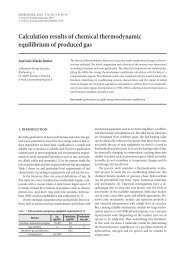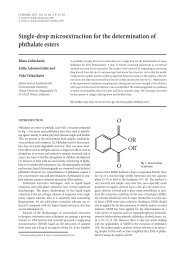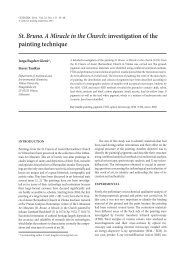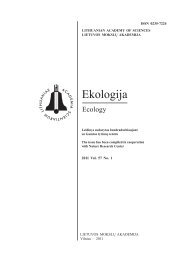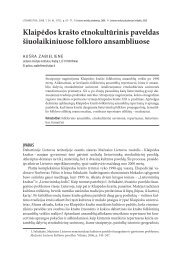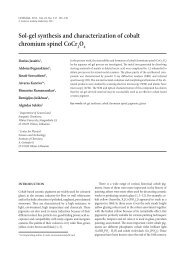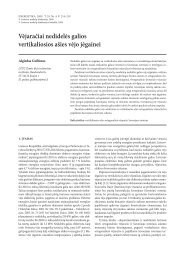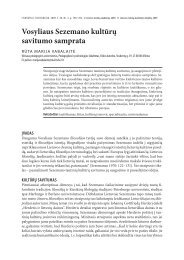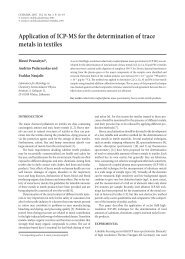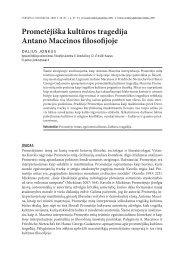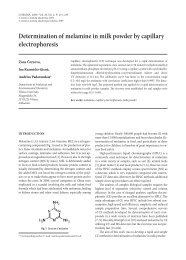Two chemotypes of essential oils produced by the - Lietuvos mokslų ...
Two chemotypes of essential oils produced by the - Lietuvos mokslų ...
Two chemotypes of essential oils produced by the - Lietuvos mokslų ...
Create successful ePaper yourself
Turn your PDF publications into a flip-book with our unique Google optimized e-Paper software.
chemija. 2009. vol. 20. No. 3. P. 195–201<br />
© lietuvos <strong>mokslų</strong> akademija, 2009<br />
© lietuvos <strong>mokslų</strong> akademijos leidykla, 2009<br />
<strong>Two</strong> <strong>chemotypes</strong> <strong>of</strong> <strong>essential</strong> <strong>oils</strong> <strong>produced</strong> <strong>by</strong> <strong>the</strong> same<br />
Juniperus communis L. growing wild in Lithuania<br />
Rita Butkienė*,<br />
Ona Nivinskienė,<br />
Danutė Mockutė<br />
Institute <strong>of</strong> Chemistry,<br />
A. Goštauto 9,<br />
LT-01108 Vilnius,<br />
Lithuania<br />
It was found for <strong>the</strong> first time that needles and berries <strong>of</strong> <strong>the</strong> same junipers growing wild<br />
in Lithuania <strong>produced</strong> <strong>essential</strong> <strong>oils</strong> <strong>of</strong> different <strong>chemotypes</strong>. The Juniperus communis L.<br />
var. communis with leaves (needles) producing sabinene-chemotype <strong>essential</strong> <strong>oils</strong> were<br />
found only in three localities from <strong>the</strong> 34 investigated habitats, beside <strong>the</strong> plants with needles<br />
biosyn<strong>the</strong>sizing α-pinene-chemotype <strong>oils</strong>. The dominant compounds in four from 49<br />
(including earlier results) investigated needle <strong>essential</strong> <strong>oils</strong> were sabinene (34.1–40.8%),<br />
α-pinene (11.7–27.8%) and terpinen-4-ol (6.9–9.3%), while in <strong>the</strong> rest needle <strong>oils</strong> <strong>the</strong> main<br />
component was α-pinene (41.2–66.5%). The first major constituent <strong>of</strong> all berry <strong>essential</strong><br />
<strong>oils</strong> under study was α-pinene (21.0–67.4 %). The second and third main constituents<br />
in unripe berry <strong>oils</strong> from bushes with needle <strong>oils</strong> <strong>of</strong> sabinene chemotype were sabinene<br />
(6.3–19.6%), myrcene (4.3–12.8%) and terpinen-4-ol (13.1%) and in <strong>the</strong> ripe berry <strong>oils</strong><br />
myrcene (7.8–18.7%) and terpinen-4-ol (3.2–9.6%). The content <strong>of</strong> sabinene in all ripe<br />
berry <strong>oils</strong> was only 0.4–2.9%.<br />
Key words: Juniperus communis, Cupressaceae, <strong>essential</strong> oil composition, needle <strong>oils</strong> rich<br />
in sabinene, berry <strong>oils</strong> rich in α-pinene, myrcene, terpinen-4-ol<br />
Introduction<br />
J. communis (Cupressaceae) <strong>essential</strong> <strong>oils</strong> <strong>of</strong> berries and<br />
branches with berries are used for healing various diseases<br />
and for <strong>the</strong> preparation <strong>of</strong> meals and beverages [1–3]. Their<br />
healing power, odour and taste depend on <strong>the</strong> composition<br />
<strong>of</strong> <strong>essential</strong> <strong>oils</strong>. Essential <strong>oils</strong> <strong>of</strong> ripe berries containing 20–<br />
30% <strong>of</strong> α-pinene, 1.0–12% <strong>of</strong> β-pinene, 1.0–35% <strong>of</strong> myrcene,<br />
2.0–12% <strong>of</strong> limonene and 0.5–10% <strong>of</strong> terpinen-4-ol were recommended<br />
for pharmaceutical uses [3].<br />
According to R. P. Adams, in <strong>the</strong> north and middle European<br />
countries J. communis var. communis is growing up to<br />
600 m above sea level. J. communis var. saxatilis grows in higher<br />
areas [4–6]. The territory <strong>of</strong> Lithuania is lower than 400 m<br />
above sea level. J. communis var. communis is <strong>the</strong> only species<br />
<strong>of</strong> <strong>the</strong> genus Juniperus growing wild in Lithuania [4, 7, 8].<br />
The leaf (needle) <strong>essential</strong> <strong>oils</strong> <strong>of</strong> J. communis var. communis<br />
are mostly <strong>of</strong> α-pinene chemotype [4, 6, 9, 10]. The<br />
needle, unripe and ripe berry <strong>essential</strong> <strong>oils</strong> <strong>of</strong> twelve junipers<br />
collected in twelve localities <strong>of</strong> Lithuania were <strong>of</strong> α-pinene<br />
(38.5–66.5%) chemotype [11–14].<br />
Some needle <strong>essential</strong> <strong>oils</strong> <strong>of</strong> J. communis from Scandinavian<br />
countries, Poland and Italy were sabinene chemotype<br />
* Corresponding author. E-mail: rita@butkus.lt<br />
beside most frequent α-pinene chemotype [9, 15–19]. The<br />
juniper berry <strong>essential</strong> <strong>oils</strong> <strong>of</strong> sabinene chemotype had been<br />
found only in high (~2000 m) mountains [3, 20, 21]. All berry<br />
<strong>essential</strong> <strong>oils</strong> in lower localities were <strong>of</strong> α-pinene chemotype<br />
[9, 15, 16, 20, 22, 23].<br />
The aim <strong>of</strong> this investigation was to test whe<strong>the</strong>r <strong>the</strong>re are<br />
any differences in <strong>the</strong> composition <strong>of</strong> <strong>essential</strong> <strong>oils</strong> <strong>of</strong> J. communis<br />
var. communis growing wild in Lithuania.<br />
Materials and methods<br />
Samples <strong>of</strong> needles, unripe and ripe berries from 37 individual<br />
juniper (J. communis L. var. communis) plants were collected<br />
in 2003–2008 in 22 localities. Voucher specimens have<br />
been deposited in <strong>the</strong> Herbarium <strong>of</strong> <strong>the</strong> Institute <strong>of</strong> Botany<br />
(BILAS numbers are presented in Table 1).<br />
The <strong>essential</strong> <strong>oils</strong> were prepared <strong>by</strong> hydrodistillation (3 h)<br />
<strong>of</strong> fresh needles, unripe and ripe berries in an apparatus according<br />
to [24]. The ratio <strong>of</strong> unripe, ripe berries and water<br />
was 1 : 10, and <strong>of</strong> needles and water 1 : 20. Oil yields from<br />
needles (∼0.37%), unripe (∼1.2%) and ripe berries (~0.9%)<br />
were obtained using 50 g <strong>of</strong> plant material and expressed in<br />
v/w% <strong>of</strong> dry weight.<br />
The <strong>essential</strong> <strong>oils</strong> were analysed <strong>by</strong> GC and GC / MS. The<br />
separation was performed on a fused silica capillary column
196<br />
Rita Butkienė, Ona Nivinskienė, Danutė Mockutė<br />
Table 1. Juniperus communis L. plants growing wild in Lithuania, collected in 2003–2008<br />
Sample No.<br />
Locality<br />
Voucher specimen<br />
number in BILAS<br />
1 Druskininkai district, Leipalingis (A) 68885<br />
2 Kaunas district, Arlaviškės (B) 68345<br />
3 Vilnius district, near Lake Baldis (C1) 68352<br />
4 Vilnius district, near Lake Baldis (C2) 68881<br />
5–7 Vilnius district, ~0.5 km to <strong>the</strong> northwest <strong>of</strong> Lake Baldis 68882<br />
8 Vilnius district, Dukštos 68331<br />
9, 10 Šalčininkai district, Gelūnai 68332, 68333<br />
11 Molėtai district, Suginčiai 68334<br />
12 Molėtai district, Plavėjai 68335<br />
13 Trakai district, 12 km to <strong>the</strong> sou<strong>the</strong>ast <strong>of</strong> Rudiškės village 68336<br />
14 Trakai district, 5 km to <strong>the</strong> south <strong>of</strong> Paluknis 68337<br />
15–19 Kaunas district, Arlaviškės 68346<br />
20, 21 Anykščiai district, Svėdasai 68343<br />
22 Vilnius district, 4 km to <strong>the</strong> east <strong>of</strong> Nemenčinė 68353<br />
23 Vilnius district, ~2 km to <strong>the</strong> northwest <strong>of</strong> Bezdonys 68868<br />
24, 25 Vilnius district, ~2.5 km to <strong>the</strong> west <strong>of</strong> Bezdonys 68869, 68870<br />
26, 27 Vilnius district, ~5 km to <strong>the</strong> southwest <strong>of</strong> Bezdonys, near Lake Tapeliai 68871, 68872<br />
28, 29 Vilnius district, ~2 km to <strong>the</strong> southwest <strong>of</strong> Bezdonys railway station 68875, 68876<br />
30 Vilnius district , 6 km to <strong>the</strong> east <strong>of</strong> Bezdonys 68880<br />
31, 32 Ignalina district, 5 km to <strong>the</strong> southwest <strong>of</strong> Dūkštas 68356, 68884<br />
33 Varėna district, ~2.5 km to <strong>the</strong> east <strong>of</strong> Zervynos 68873<br />
34 Varėna district, ~4.5 km to <strong>the</strong> east <strong>of</strong> Zervynos 68874<br />
35, 36 Anykščiai district, ~3.5 km to <strong>the</strong> nor<strong>the</strong>ast <strong>of</strong> Svėdasai 68877, 68878<br />
37 Vilnius district, ~3 km to <strong>the</strong> northwest <strong>of</strong> Šilėnai village 68879<br />
DB-5 (50 m × 0.32 mm; film thickness 0.25 µm) and DB-5 Wax<br />
(50 m × 032 mm, film thickness 0.25 µm) with an HP 5890II<br />
chromatograph equipped with FID. The GC oven temperature<br />
was programmed as follows: from 60 °C (iso<strong>the</strong>rmal for<br />
3 min) increased to 160 °C at <strong>the</strong> rate <strong>of</strong> 5 °C/min (iso<strong>the</strong>rmal<br />
for 1 min) and to 250 °C at <strong>the</strong> rate <strong>of</strong> 10 °C/min, and <strong>the</strong><br />
final temperature was kept for 3 min. The temperature <strong>of</strong> <strong>the</strong><br />
injector and detector were 250 °C. The flow rate <strong>of</strong> <strong>the</strong> carrier<br />
gas (helium) was 1 ml/min. Analyses <strong>by</strong> GC / MS were carried<br />
out with a HP 5890 gas chromatograph equipped with an<br />
HP 5971 mass selective detector and HP 7673 split / splitless<br />
(splitless 0.75 min) injector. Mass spectra in electron mode<br />
were generated at 70 eV, 0.97 scans / second, mass range<br />
35–650 m/z.<br />
The percentage composition <strong>of</strong> <strong>the</strong> <strong>essential</strong> <strong>oils</strong> was<br />
computed from GC peak areas without correction factors.<br />
Qualitative analysis was based on a comparison <strong>of</strong> retention<br />
indexes and mass spectra with corresponding data in <strong>the</strong> literature<br />
[25] and <strong>the</strong> computer mass spectra libraries (Wiley<br />
and NBS 54K).<br />
Results and discussion<br />
Thirty-seven plant samples <strong>of</strong> J. communis var. communis were<br />
collected in 22 localities. Results are summarized in Tables 2<br />
and 3. We found that 1–4 samples (Table 1: A, B, C1 and C2)<br />
<strong>of</strong> needle <strong>essential</strong> <strong>oils</strong> were <strong>of</strong> sabinene chemotype. Table 2<br />
contains detailed data on <strong>the</strong>se four samples. The content <strong>of</strong><br />
dominant sabinene (Table 2; 34.1–40.8%) in <strong>the</strong> needle <strong>essential</strong><br />
<strong>oils</strong> under study exceeded <strong>the</strong> quantities <strong>of</strong> <strong>the</strong> second<br />
major compound α-pinene (11.7–27.8%). The third main<br />
constituent was terpinen-4-ol (6.9–9.3%) in <strong>the</strong>se needle <strong>oils</strong>.<br />
The composition <strong>of</strong> <strong>the</strong> berry <strong>essential</strong> <strong>oils</strong> markedly differed<br />
from that <strong>of</strong> <strong>the</strong> needle <strong>oils</strong>. The prevailed constituent in all<br />
berry <strong>oils</strong> was α-pinene (20.3–50.6%). For better evidence,<br />
<strong>the</strong> distribution <strong>of</strong> <strong>the</strong> main compounds <strong>of</strong> leaf, unripe and<br />
ripe berry <strong>oils</strong> is presented in Figure. The unripe berry <strong>essential</strong><br />
<strong>oils</strong> from A, B, C1 and C2 samples contained sabinene<br />
(6.3–12.3%) in <strong>the</strong> second or third position. The rest <strong>oils</strong> in<br />
this study (for samples 5–37 only characteristic compounds<br />
were identified) and formerly [11–14] analysed unripe berry<br />
<strong>oils</strong> from juniper with needles biosyn<strong>the</strong>sizing α-pinene<br />
chemotype <strong>oils</strong> included only 1.5–1.9% <strong>of</strong> sabinene (Tables<br />
2 and 3). The ripe berry <strong>essential</strong> <strong>oils</strong> were similar in<br />
all investigated plants (Table 3) and were rich in α-pinene.<br />
The content <strong>of</strong> sabinene in all ripe berry <strong>oils</strong> varied from<br />
0.4 to 2.9%.<br />
The content <strong>of</strong> compounds with sabinane and pinane<br />
carbon skeletons in needle, unripe and ripe berry <strong>essential</strong><br />
<strong>oils</strong> <strong>of</strong> different <strong>chemotypes</strong> varied markedly (Table 4). The<br />
needle <strong>oils</strong> included 36.5–46.0% constituents with <strong>the</strong> sabinane<br />
carbon skeleton (SCS) and 13.0–28.9% with <strong>the</strong> pinane<br />
carbon skeleton (PCS). An opposite ratio <strong>of</strong> <strong>the</strong> corresponding<br />
compounds were found in unripe (6.7–15.3% <strong>of</strong> SCS and<br />
24.6–50.8% <strong>of</strong> PCS) and ripe berry (2.1–3.5% <strong>of</strong> SCS and<br />
22.6–41.4% <strong>of</strong> PCS) <strong>essential</strong> <strong>oils</strong>.
<strong>Two</strong> <strong>chemotypes</strong> <strong>of</strong> <strong>essential</strong> <strong>oils</strong> <strong>produced</strong> <strong>by</strong> <strong>the</strong> same Juniperus communis L. growing wild in Lithuania<br />
197<br />
Table 2. The chemical composition (%) <strong>of</strong> leaf, unripe and ripe berry <strong>essential</strong> <strong>oils</strong> <strong>of</strong> J. communis L. growing wild in Lithuania a<br />
Compound<br />
RI<br />
A B C1 C2<br />
Leaves Unripe Ripe Leaves Unripe Ripe Leaves Unripe Ripe Leaves Unripe Ripe<br />
2-Hexenal 855 0.1 3.2 0.2 0.1 – – tr tr 0.1 tr – 0.1<br />
α-Thujene 930 2.7 1.1 0.5 0.4 0.1 0.1 0.5 0.4 – 0.1 0.2 0.3<br />
α-Pinene 939 11.7 22.2 36.4 17.9 50.6 38.7 19.5 43.5 21.0 27.8 34.8 22.3<br />
Camphene 954 tr 0.1 0.3 tr 0.3 0.2 – 0.1 0.4 0.2 – 0.3<br />
Verbenene 968 tr – 0.1 – – 0.1 – – – – – 0.2<br />
Sabinene 975 40.8 12.3 1.6 37.9 6.3 2.9 34.1 8.2 2.5 38.7 10.2 2.9<br />
β-Pinene 979 0.5 2.0 2.8 tr 0.2 0.7 0.4 0.1 0.5 0.5 2.2 0.4<br />
Myrcene 991 3.9 7.1 11.5 2.6 19.6 18.7 3.1 13.5 17.4 2.9 6.0 7.8<br />
δ-2-Carene 1002 – – – – – – 0.4 – – – – –<br />
α-Phellandrene 1003 0.3 0.2 0.2 0.8 0.1 tr 0.3 0.1 – tr 1.2 0.2<br />
δ-3-Carene 1011 1.8 tr tr 1.4 0.1 0.1 0.4 0.1 - 0.2 - -<br />
α-Terpinene 1017 3.0 1.9 1.0 2.0 0.4 0.5 2.5 0.2 0.5 1.2 0.9 1.1<br />
p-Cymene 1025 0.5 0.1 0.4 0.2 tr 0.3 0.4 0.1 0.3 0.1 0.1 1.3<br />
Limonene 1029 2.6 1.8 2.5 2.6 2.7 2.7 2.4 2.5 1.1 2.1 2.2 2.3<br />
β-Phellandrene 1030 0.8 0.5 1.2 1.0 0.2 0.6 1.1 0.3 1.1 0.9 0.5 0.2<br />
(E)-β-Ocimene 1050 0.1 – – 0.1 – – 0.3 – – 0.1 – –<br />
γ-Terpinene 1060 4.1 3.3 1.8 3.2 0.8 0.9 3.9 1.0 1.9 2.2 1.7 1.6<br />
cis-Sabinene<br />
hydrate<br />
1070 1.1 0.8 0.1 0.6 0.2 0.5 0.7 0.2 - 0.4 0.1 -<br />
cis-Linalool oxide 1072 – – – – 0.2 – – 0.1 – – tr –<br />
Terpinolene 1089 3.3 2.0 1.3 2.4 1.2 1.5 2.9 1.4 0.6 1.5 1.7 1.2<br />
p-Cymenene 1091 – – – – – – – – 0.2 – – –<br />
Linalool 1097 – 0.2 0.5 0.1 0.1 1.2 – tr – – – –<br />
trans-Sabinene<br />
hydrate<br />
1098 1.0 1.1 – 0.4 0.1 – 0.5 tr – 0.3 0.1 –<br />
Isoamyl-2-methylbutyrate<br />
1100 0.3 – – 0.1 – – – – – – – –<br />
α-Thujone 1102 0.2 – – tr – – 0.1 – – 0.4 – –<br />
p-Mentha-1,3,8-<br />
triene<br />
1110 – – – tr 0.1 0.4 – – – – – 0.2<br />
β-Thujone 1114 – – – – – – 0.4 – – 0.2 – –<br />
3-Methyl-3-butenyl<br />
isovalerate<br />
1115 0.4 0.1 – – – – – 0.2 – – 0.1 –<br />
α-Fenchol 1117 – – 0.1 – – 0.2 – – tr – – –<br />
cis-p-Mentha-2-en-<br />
1-ol<br />
1122 0.2 0.8 0.4 0.5 0.1 0.2 0.6 0.2 - 0.3 0.1 tr<br />
α-Campholenal 1126 – – 0.2 – – 0.2 – – 0.2 – – 0.7<br />
cis-p-Mentha-2,8-<br />
dien-1-ol<br />
1137 – – 0.2 – – – – – – – – 0.2<br />
trans-Pinocarveol 1139 0.4 – 0.3 tr – 0.3 – – 0.1 – – 0.8<br />
trans-p-Menth-2-<br />
en-1-ol<br />
1140 0.8 0.7 – – – – 0.5 0.3 – – 0.2 –<br />
3-Methyl-2-butenyl-<br />
2-methyl butanoate<br />
1141 0.5 tr – 0.3 – – – – – – – –<br />
trans-Verbenol 1145 0.1 tr 0.2 tr tr 0.2 – tr – tr – 0.2<br />
Camphor 1146 – – 0.1 – – 0.2 – tr – 0.1 – 0.2<br />
Camphene hydrate 1152 – – 0.1 – – tr – – – tr – tr<br />
p-Menth-1(7),2-en-<br />
8-ol<br />
1156 tr – – – – – tr – tr – – tr<br />
Sabina ketone 1159 0.1 – – – – – – – – – – 0.1<br />
Borneol 1169 – tr 1.1 0.1 tr 1.1 – 0.1 0.8 0.1 – 0.7<br />
p-Mentha-1,5-dien-<br />
8-ol<br />
1170 tr – 0.5 – tr 0.7 – tr 1.0 – – 1.4<br />
Terpinen-4-ol 1177 9.3 13.1 8.7 7.1 2.4 3.2 7.9 3.5 9.6 6.9 5.4 7.1<br />
p-Cymen-8-ol 1183 tr 0.1 0.6 0.1 tr 0.4 0.1 0.2 0.1 0.1 0.1 2.3<br />
α-Terpineol 1189 0.9 1.1 4.3 0.6 0.5 2.0 0.6 0.7 2.9 0.6 0.7 5.0<br />
Myrtenol 1196 – – 0.6 – – 0.3 0.1 – 0.1 0.1 – 0.6<br />
cis-Piperitol 1197 0.2 0.3 0.2 0.2 tr – 0.1 tr 0.1 0.1 – 0.2<br />
Dodecane 1200 – – – – – – 0.1 – – tr – –
198<br />
Rita Butkienė, Ona Nivinskienė, Danutė Mockutė<br />
Table 2 (continued)<br />
Compound<br />
RI<br />
A B C1 C2<br />
Leaves Unripe Ripe Leaves Unripe Ripe Leaves Unripe Ripe Leaves Unripe Ripe<br />
trans-Dihydro<br />
carvone<br />
1201 – – 0.3 – – tr – – – – – 0.6<br />
Verbenone 1205 – – 0.8 – – 0.6 – – 0.8 – – 1.6<br />
trans-Piperitol 1208 0.3 0.3 – 0.1 – – 0.2 0.1 – tr – –<br />
trans-Carveol 1217 – tr 0.1 – tr 0.1 – 0.1 – – – 0.1<br />
endo-Fenchyl<br />
acetate<br />
1220 – – – tr tr – – tr – – – –<br />
Citronellol 1226 – – 0.4 tr tr 0.4 – tr – – – tr<br />
Nerol 1229 – – – – – 0.1 – – – – – –<br />
Methyl thymol 1235 tr – – tr – – 0.2 tr – 0.2 – tr<br />
trans-Chrysan <strong>the</strong>nyl<br />
acetate<br />
1238 0.1 0.1 0.1 – tr – – – – – – –<br />
Carvacrol, methyl<br />
e<strong>the</strong>r<br />
1245 0.1 tr – 0.1 – – 0.2 tr – 0.1 – –<br />
Piperitone 1253 tr tr – tr – – tr – – – – –<br />
Methyl citronellate 1261 0.3 0.7 0.8 0.1 1.8 0.6 – 0.9 0.1 tr 0.3 0.5<br />
Geranial 1267 – – – – 0.1 – – tr – – – –<br />
α-Terpinen-7-al 1285 – – – 0.1 – – – – – – – 0.1<br />
Bornyl acetate 1289 0.3 0.6 0.9 0.5 1.3 1.1 0.6 1.1 0.7 0.5 1.1 0.9<br />
Thymol 1290 tr tr 0.1 – – – – – tr – tr 0.1<br />
trans-Sabinyl<br />
acetate<br />
1291 – – – 0.1 – – 0.2 – – 0.1 – –<br />
(2E, 4Z)-Decadienal 1293 tr – – tr – – – – – – – –<br />
2-Undecanone 1294 – – – – – 0.1 0.1 – – 0.1 – 0.1<br />
Thujanol acetate 1295 – – – – – – 0.1 – – 0.1 – –<br />
trans-Pinocarvyl<br />
acetate<br />
1298 0.1 0.2 – – – tr – 0.1 – – – –<br />
Terpinen-4-ol<br />
acetate<br />
1299 tr – – tr – – 0.1 – – 0.4 – –<br />
Tridecane 1300 – – tr – – – 0.1 – – – – –<br />
Myrtenyl acetate 1327 tr tr 0.1 0.1 tr 0.1 1.2 0.1 0.1 – – 0.1<br />
δ-Elemene 1338 0.1 0.1 0.1 0.1 0.1 0.1 0.7 0.2 0.1 0.4 – 0.1<br />
trans-Carvyl acetate 1342 – tr – – tr – – tr – – – –<br />
α-Terpinyl acetate 1349 0.1 0.3 0.4 tr 0.1 – 0.2 0.2 – 0.1 0.2 0.1<br />
Citronellyl acetate 1353 tr tr tr 0.2 0.3 0.1 0.1 0.2 0.1 0.1 tr 0.3<br />
Neryl acetate 1362 – – – 0.1 – – – – – – – –<br />
α-Copaene 1377 tr tr tr tr – tr 0.1 tr 0.1 tr – 0.1<br />
Geranyl acetate 1379 – – – – – 0.1 0.1 – – tr – tr<br />
trans-Myrtanol<br />
acetate<br />
1387 0.1 0.1 tr 0.1 tr – 0.6 tr 0.5 – tr<br />
β-Elemene 1391 0.2 0.3 0.3 0.5 0.3 0.2 0.3 0.2 0.3 0.4 0.4 0.3<br />
Longifolene 1408 – – tr tr – 0.2 – – tr – – 0.1<br />
β-Caryophyllene 1418 0.1 0.1 0.3 0.2 0.5 0.1 0.1 0.4 0.2 0.2 0.3 0.2<br />
β-Ylangene 1421 0.1 0.1 – – – – – – – – – –<br />
β-Gurjunene 1434 – tr – – tr tr 0.1 tr – tr tr tr<br />
γ-Elemene 1437 tr – 0.1 0.3 0.3 1.1 0.9 0.5 1.1 0.1 0.3 0.2<br />
(Z)-β-Farnesene 1443 tr – 0.1 – 0.1 – – 0.1 – – – –<br />
cis-Muurola-3,5-<br />
diene<br />
1450 tr tr – 0.1 – – tr – – tr – –<br />
trans-Muurola-3,5-<br />
diene<br />
1454 tr tr tr 0.1 tr tr tr tr – tr – tr<br />
α-Humulene 1455 0.1 0.1 0.3 0.2 0.5 0.2 0.2 0.4 0.3 0.3 0.3 0.2<br />
(E)-β-Farnesene 1457 – – – tr – 0.3 tr – tr tr 0.1 –<br />
cis-Muurola-4(14),5-<br />
diene<br />
1467 tr tr tr 0.2 tr – 0.1 0.1 tr – 0.1 tr<br />
trans-Cadina-1(6),4-<br />
diene<br />
1477 tr tr tr 0.1 tr tr tr tr tr – 0.1 tr<br />
γ-Muurolene 1480 tr 0.1 tr 0.2 0.1 0.1 0.1 tr 0.4 0.1 0.1 0.1<br />
Germacrene D 1485 0.1 0.5 0.4 0.2 0.4 0.3 0.7 0.5 0.7 0.5 1.8 0.6<br />
Citronellyl isobutyrate<br />
1487 – – – – – – – – 0.5 – – –
<strong>Two</strong> <strong>chemotypes</strong> <strong>of</strong> <strong>essential</strong> <strong>oils</strong> <strong>produced</strong> <strong>by</strong> <strong>the</strong> same Juniperus communis L. growing wild in Lithuania<br />
199<br />
Table 2 (continued)<br />
Compound<br />
RI<br />
A B C1 C2<br />
Leaves Unripe Ripe Leaves Unripe Ripe Leaves Unripe Ripe Leaves Unripe Ripe<br />
(E)-β-Ionone 1489 tr – – tr – tr – – tr – 0.2 0.4<br />
β-Selinene 1490 – – – 0.1 tr – tr tr – tr – –<br />
epi-Cubebol 1493 tr 0.1 – 0.1 0.1 – tr 0.1 – 0.2 0.2 –<br />
trans-Muurola-4-<br />
(14),5-diene<br />
1494 0.3 – – 0.2 – 0.1 – – tr tr – 0.1<br />
Bicyclogermacrene 1499 – – – – 0.1 0.2 – tr – – – –<br />
α-Muurolene 1500 0.2 0.2 0.3 0.5 0.1 0.2 0.4 0.1 0.9 – 0.2 0.6<br />
β-Bisabolene 1506 tr tr – 0.2 – – – – – – – –<br />
γ-Cadinene 1514 0.1 0.2 0.2 0.6 0.2 0.3 0.2 0.2 1.1 0.1 1.2 1.8<br />
endo-1-Bourbonalol 1520 tr 0.2 – – 0.2 0.1 – 0.2 0.1 – – –<br />
δ-Cadinene 1523 0.7 1.2 0.9 1.8 0.5 0.1 0.8 0.7 2.9 0.7 0.6 2.7<br />
Citronellyl butyrate 1532 0.2 0.5 0.2 – 0.1 0.1 0.2 0.1 0.3 0.2 0.6 0.1<br />
10-epi-Cubebol 1534 – – – – 0.2 – – – 0.1 – – –<br />
trans-Cadina-1,4-<br />
diene<br />
1535 tr tr – 0.1 tr 0.1 tr tr tr – 0.2 0.1<br />
α-Cadinene 1539 tr tr 0.1 0.3 0.1 0.2 0.2 tr 0.5 – – 0.1<br />
cis-Sesquisabinene<br />
hydrate<br />
1544 – – – – – – 0.1 – – 0.1 – –<br />
α-Calacorene 1546 – – – tr – 0.1 0.1 – 0.2 – – 0.1<br />
Elemol 1550 0.2 0.4 0.2 0.3 0.8 0.4 0.6 0.7 0.5 0.4 0.8 0.5<br />
Germacrene B 1561 tr 0.1 0.1 0.2 0.2 0.6 0.5 0.3 0.4 0.4 0.2 0.2<br />
(E)-Nerolidol 1563 – tr – – tr – – – – – – –<br />
(Z)-3-Hexenyl<br />
benzoate<br />
1566 – – – 0.1 tr – 0.1 tr – – 0.2 –<br />
Germacrene D-4-ol 1576 0.5 0.4 0.6 0.7 0.6 – – 0.5 0.2 0.2 – 0.4<br />
Spathulenol 1578 0.3 0.4 0.3 0.2 0.2 0.7 0.7 0.3 1.2 0.6 1.0 0.5<br />
Caryophyllene<br />
oxide<br />
1583 0.1 0.1 0.2 0.4 – 0.3 tr tr 0.9 tr – 0.2<br />
Viridiflorol 1593 0.6 0.8 – – – – – – – – – –<br />
Salvial-4(14)en-1-<br />
one<br />
1595 – – – – – – – – 0.4 – – –<br />
Ethyl dodecanoate 1595 tr tr – – 0.1 0.1 0.1 0.1 – 0.1 – 0.1<br />
β-Oplopenone 1607 – 0.1 0.1 – – – – – 0.1 – – –<br />
Humulene<br />
epoxide II<br />
1608 0.2 0.2 0.2 – – 0.4 – – 1.2 – – 0.2<br />
1, 10-di-epi-Cubenol 1619 – 0.2 0.1 0.1 – – – – 0.3 – – tr<br />
1-epi-Cubenol 1629 0.1 0.1 0.2 0.3 0.4 0.4 0.1 0.3 0.8 0.4 0.2 0.3<br />
γ-Eudesmol 1632 tr tr 0.1 – – 0.3 0.1 – 0.5 – tr 0.2<br />
epi-α-Cadinol 1640 0.2 0.8 1.1 0.9 0.1 0.7 – 0.1 2.1 0.4 0.2 0.7<br />
epi-α-Muurolol 1642 0.3 0.7 0.9 0.7 1.1 0.6 0.8 1.0 2.4 0.5 3.0 0.6<br />
α-Muurolol 1646 0.1 0.3 0.7 0.5 0.1 0.3 tr 0.1 1.2 0.4 1.2 0.4<br />
α-Cadinol 1654 1.0 2.8 4.4 3.5 1.6 2.3 1.3 2.3 7.6 1.1 5.9 6.4<br />
Selin-11-en-4-α-ol 1660 – – 0.1 – 0.1 – – 0.1 – – – tr<br />
14-hydroxy-9-epi-β-<br />
Caryophyllene<br />
1670 tr 0.3 0.3 0.2 – 0.1 0.2 tr 1.1 0.2 – 0.2<br />
n-Tetradecanol 1673 – – – – – – – – 1.5 – – –<br />
Khusinol 1680 – tr – – tr – – tr – – – –<br />
Eudesma-4(15),7-<br />
dien-1-β-ol<br />
1688 – tr 0.5 0.1 – 0.2 – – 0.8 – – 0.7<br />
Shyobunol 1689 – – – – – – 0.4 – – – 0.9 –<br />
(6Z, 2Z)-Farnesol 1697 tr 0.1 tr – – – – – – – – tr<br />
Eudesm-7(11)-en-<br />
4-ol<br />
1700 – tr 0.5 – – – 0.3 – – 0.1 – 0.2<br />
14-hydroxy-α-<br />
Humulene<br />
1714 – – 0.1 0.1 – 0.3 0.2 tr tr – 0.1 0.3<br />
Nootkatol 1715 – 0.1 0.1 tr tr – – – – – –<br />
Oplopanone 1740 – – – – – 0.5 – – – – – –<br />
17-hydroxy-δ-<br />
Cadinene<br />
1803 – – – – – tr – – – tr tr 0.1
200<br />
Rita Butkienė, Ona Nivinskienė, Danutė Mockutė<br />
Table 2 (continued)<br />
Compound<br />
RI<br />
A B C1 C2<br />
Leaves Unripe Ripe Leaves Unripe Ripe Leaves Unripe Ripe Leaves Unripe Ripe<br />
Nootkatone 1806 – 0.1 0.1 – tr 0.1 – 0.1 – – – –<br />
Cyclopentadecanolide<br />
1834 tr 0.1 0.2 tr tr 0.4 0.1 tr 0.2 tr 0.2 0.3<br />
Manool oxide 1987 0.2 0.1 – – – – tr – – – 0.1 tr<br />
epi-13-Manool<br />
oxide<br />
2010 – – – – – – tr – – – 0.1 tr<br />
Abietatriene 2057 – – 0.1 – tr 0.1 0.1 0.1 tr tr 0.1 0.1<br />
Octadecanol 2078 tr – tr – – – – – – – – –<br />
Abietadiene 2088 tr – tr tr – tr 0.1 tr tr tr 0.1 0.1<br />
Sandaracopimaral 2185 – – 0.1 – – tr – – – – – –<br />
dehydro-Abietal 2275 – – – – – – tr tr tr tr 0.1 tr<br />
Total 98.9 90.1 98.5 97.9 98.9 95.7 98.7 89.7 97.6 98.5 91.1 87.1<br />
a tr – traces (
<strong>Two</strong> <strong>chemotypes</strong> <strong>of</strong> <strong>essential</strong> <strong>oils</strong> <strong>produced</strong> <strong>by</strong> <strong>the</strong> same Juniperus communis L. growing wild in Lithuania<br />
201<br />
Figure. The mean values <strong>of</strong> major constituents in junipers producing two <strong>chemotypes</strong><br />
<strong>of</strong> <strong>essential</strong> <strong>oils</strong><br />
Conclusions<br />
It was found for <strong>the</strong> first time that needles <strong>produced</strong> <strong>essential</strong><br />
<strong>oils</strong> <strong>of</strong> sabinene chemotype and berries <strong>of</strong> α-pinene chemotype<br />
from <strong>the</strong> same juniper growing wild in Lithuania. The<br />
Juniperus communis L. var. communis with leaves (needles)<br />
producing sabinene-chemotype <strong>essential</strong> <strong>oils</strong> were found<br />
only in three localities from <strong>the</strong> 34 investigated habitats, beside<br />
plants with needles biosyn<strong>the</strong>sizing α-pinene-chemotype<br />
<strong>oils</strong>.<br />
References<br />
Received 8 May 2009<br />
Accepted 18 May 2009<br />
1. R. Balz, Healing Power <strong>of</strong> Essential Oils, Lotus Light, Twin<br />
Lakes, USA (1996).<br />
2. J. Lawless, The Illustrated Encyclopaedia <strong>of</strong> Essential Oils,<br />
Element Books, Singapore (1999).<br />
3. E. Teuscher, in: Medicinal Spices, 205, Medpharm Scientific<br />
Publishing, Stuttgart (2006).<br />
4. R. P. Adams, Biochem. Syst. Ecol., 26, 637 (1998).<br />
5. R. P. Adams, R. N. Pandey, J. W. Leverenz, N. Dignard,<br />
K. Hoegh, T. Thorfinnsson, Biochem. Syst. Ecol., 31, 181<br />
(2003).<br />
6. R. P. Adams, Junipers <strong>of</strong> <strong>the</strong> World: The Genus Juniperus, 85,<br />
Trafford Publishing Co., Vancouver (2004).<br />
7. M. Natkevičaitė-Ivanauskienė (ed.), <strong>Lietuvos</strong> TSR flora, 1,<br />
182, Vilnius (1959)<br />
8. M. Navasaitis, Dendrologija, 244, Margi raštai, Vilnius<br />
(2004).<br />
9. B. M. Lawrence, in: Essential Oils 2001–2004, 36, Allured<br />
Publishing Corp., Carol Stream, IL, USA (2006).<br />
10. J. Mastelic, M. Milos, D. Kustrak, A. Radonic, Croatica<br />
Chemica Acta, 73, 585 (2000).<br />
11. R. Butkienė, O. Nivinskienė, D. Mockutė, J. Essent. Oil<br />
Bearing Plants, 8, 140 (2005).<br />
12. R. Butkienė, O. Nivinskienė, D. Mockutė, J. Essent. Oil<br />
Bearing Plants, 9, 144 (2006).<br />
13. R. Butkienė, O. Nivinskienė, D. Mockutė, J. Essent. Oil Res.,<br />
18, 489 (2006).<br />
14. R. Butkienė, O. Nivinskienė D. Mockutė, A. Miliūtė, Chemija,<br />
18, 35 (2007).<br />
15. A. Angioni, A. Barra, M. T. Russo, V. Coroneo, S. Dessi,<br />
P. Cabras, J. Agric. Food Chem., 51, 3073 (2003).<br />
16. N. Filipowicz, A. Piotrowski, J. R. Ochocka, M. Asztemborska,<br />
Planta Medica, 72, 850 (2006).<br />
17. R. Hiltunen, I. Laakso, Flavour Fragr. J., 10, 203 (1995).<br />
18. J. R. Ochocka, M. Asztemborska, D. R. Zook, D. Sybilska,<br />
G. Perez, L. Ossicini, Phytochemistry, 44, 869 (1997).<br />
19. A. Wibe, A.-K. Borg-Karlson, M. Persson, T. Norin,<br />
H. Mustaparta, J. Chem. Ecol., 24, 273 (1998).<br />
20. B. M. Lawrence, in: Essential Oils 1995–2000, 53, Allured<br />
Publishing Corp., Carol Stream, IL, USA (2003).<br />
21. F. Shahmir, L. Ahmadi, M. Mirza, S. A. A. Korori, Flavour<br />
Fragr. J., 18, 425 (2003).<br />
22. B. M. Lawrence, in: Essential Oils 1981–1987, 110–111,<br />
140–141, 240–241, Allured Publishing Corp., Carol Stream,<br />
IL, USA (1989).<br />
23. B. M. Lawrence, in: Essential Oils 2005–2007, 60, Allured<br />
Publishing Corp., Carol Stream, IL, USA (2008).<br />
24. European Pharmacopoeia, 3rd ed., 121, Directorate for<br />
<strong>the</strong> quality <strong>of</strong> medicines, Council <strong>of</strong> Europe, Strasbourg,<br />
France (1996).<br />
25. R. P. Adams, Identification <strong>of</strong> Essential Oil Components <strong>by</strong><br />
Gas Chromatography / Mass Spectrometry, 4th ed., Allured<br />
Publishing Corp., Carol Stream, IL, USA (2007).<br />
Rita Butkienė, Ona Nivinskienė, Danutė Mockutė<br />
Dviejų chemotipų eteriniai aliejai, biosintetinami<br />
to paties Lietuvoje augančio laukinio<br />
kadagio (Juniperus communis L.)<br />
Santrauka<br />
Pirmą kartą buvo nustatyta, kad iš to paties kadagio spyglių ir uogų<br />
išskirti eteriniai aliejai yra skirtingo chemotipo. Trijose iš trisdešimt<br />
keturių augaviečių rasti Juniperus communis L. var. communis,<br />
kurių spygliuose sintetinasi sabineno chemotipo eteriniai aliejai.<br />
Visų kitų tirtų kadagių spyglių aliejai buvo α-pineno chemotipo.<br />
Keturiuose iš keturiasdešimt devynių (įskaitant ir anksčiau tirtus)<br />
kadagio spyglių eterinių aliejų vyravo sabinenas (34,1–40,8 %),<br />
α-pinenas (11,7–27,8 %) ir terpinen-4-olis (6,9–9,3 %). α-Pinenas<br />
(41,2–66,5 %) buvo pagrindinis komponentas visuose kituose<br />
spyglių aliejuose. Visuose tirtuose uogų eteriniuose aliejuose vyravo<br />
α-pinenas (21,0–67,4 %). Neprinokusių uogų aliejuose nuo<br />
krūmų su spygliais, sintetinančiais sabineno chemotipo aliejus,<br />
kiti vyraujantys junginiai buvo sabinenas (6,3–19,6 %), mircenas<br />
(4,3–12,8 %) ir terpinen-4-olis (13,1 %), o prinokusių uogų aliejuose<br />
– mircenas (7,8–18,7 %) ir terpinen-4-olis (3,2–9,6 %). Visuose<br />
prinokusių uogų aliejuose buvo 0,4–2,9 % sabineno.



